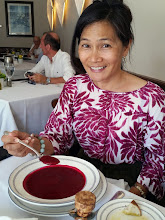 | |
| Gingerbread men from Whole Foods: Crunchy mini-mes by Nikki's Cookies with a long and tall from Jacqueline's Cookies. |
The New York Times recently ran an article on pierniki, a specialty of Torun, Poland, that dates back to 1380. The name comes from the Polish word pieprz, or pierny, meaning a peppery flavor. Modern gingerbread recipes consistently include a mixture of cinnamon, clove, ginger, and nutmeg - black pepper is not as frequently included although it is part of the authentic pierniki formula.
 |
| Boiled honey and candied orange zest give leckerli their sunny flavor base despite their wintry appeal. |
And to satisfy my urge to roll and cut dough in festive shaped, I found a recipe on the blog, Pecan Pies & Tomato Tarts for honey spice cut-outs. The recipe allows for either molasses or honey to be used to sweeten the rich dough. I opted for molasses, which yielded a chewy cookie that was easy to roll and shape, with a great aroma that improves with age.
 |
| Unicorns are my new deer: Honey spice cut-outs await the oven. |
Finally, when the need for a gingerbread fix arises,
 |
| Gingerbread man from Peet's Coffee and Tea adds nostalgia to the coffee break. |
There must be a reason that the melange of spices used to flavor gingerbread and other holiday resurface every year for the winter palate. Cinnamon is said to have cognitive and psychological benefits - I actually
give my morning Americano a good sprinkle of it every day. Although a very subtle spice, nutmeg is helpful to circulation and reducing insomnia. Among many other qualities, ginger is the only source of gingerol, a known anti-inflammatory aid and antioxidant. And cloves aid digestion, control blood sugar levels (how it does this in a cookie, I don't know), and boosts immunity.
Obviously, there is some physiological draw to foods that warm up us or cool us down, depending on the weather. But during the holidays or any other festive occasion, there is a psychological attraction to the creature comforts that take us back to a simpler time. All the rushing about at the holidays is worth it when you can revisit childhood and recall happy times by just baking - or eating - a cookie.
Merry Christmas, Happy Hanukkah, and a wondrous New Year to you! Thank you for reading GMS!
Other Sources:
Weaver, William Woys. "America Eats: Forms of Edible Folk Art" (New York: Harper & Row, 1989. Print)




